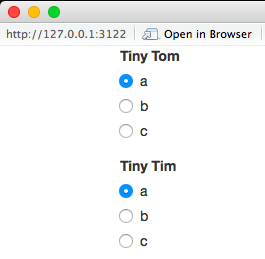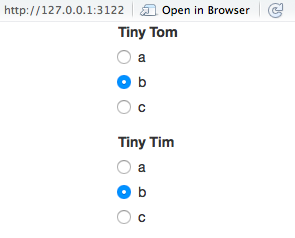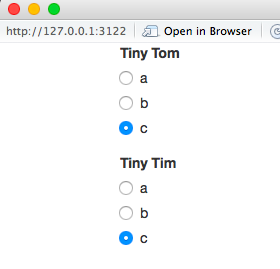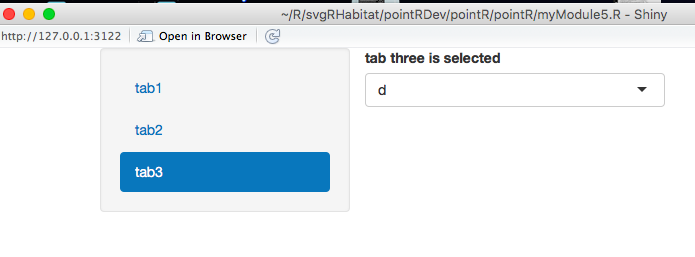Syncing Shiny Modules
Why Shiny Modules
So you might ask why use Shiny modules?
- Namespace management
- All interactions with the container (or other modules) must be Explicit.
- Clearer development and maintenance.
- Promote reusability
- And had extremely high cool factor.
Convinced? If not, go through the tutorials in
After taking the Tour
Ok, so after learning about Modules, and seeing how they cans solve much of the messiness involved in developing and maintaining a Shiny applications, it seemed only appropriate to try some simple experiments.
Let’s assume that we all seen some examples of using modules which provide support for performing the sequence of selecting/reading and plotting data.
But what about things not quite so linear? That’s what I like to investigate at here. But first a quick review.
Quick Review
Shiny Modules consist of 2 components
- a UI component (named tinyUI below)
- a Server component (named tiny below)
If running the
- UI/Server Configuration, it’s best to place the module in a separate file and source it in a file name global.R
- app configuration, probably want to just include in the app.file (as below)
A Minimalistic Example: Tiny
library(shiny)
# A module named Tiny
tinyUI <- function(id, input, output) { # module ui
ns <- NS(id)
tagList(radioButtons(ns("RB"), label="To Toggle", choices=letters[1:3]))
}
tiny<-function(input,output,session){} # module server (do nothing here)
# The shiny app
shinyApp(
fixedPage( tinyUI("toggle") ), #ui
function(input, output, session) {callModule(tiny, "toggle" )} #server
)

The Tale of Two Toggles
In this section, in order to illustrate how to pass information between modules, we consider a somewhat contrived problem:
- two sets input radio buttons built as tiny Modules
- both residing on the same page
- both intended to do the same work.
That means the the values for each should be synched together.
However, as a first step let’s just create 2 instances of toggles.
To this end we must add 2 instances of tinyUI to the ui shiny ui
fixedPage( tinyUI("Tom"), tinyUI("Tim") )
and to add two callModules for those instances to the server portion
function(input, output, session) { #app server
callModule(tiny, "Tom" )
callModule(tiny, "Tim" )
}
Additionally, to distinguish our controls, lets change the label in the tinyUI using the id
label=paste("Tiny", id)
Thus we have
tinyUI <- function(id, input, output) {
ns <- NS(id)
tagList(radioButtons(ns("RB"), label=paste("Tiny", id), choices=letters[1:3]))
}
tiny<-function(input,output,session){} # do nothing
# The shiny app
shinyApp(
fixedPage( tinyUI("Tom"), tinyUI("Tim") ), #ui
function(input, output, session) {# app server
callModule(tiny, "Tom" )
callModule(tiny, "Tim" )
}
)
And upon running we see

However these two sets of toggles are not connected in anyway. Connecting them will require using reactives. Again the goal is
- make Toms choice propagate to Tim.
- make Tims choice propagate to Tom.
To do that we modify the server portion of the tiny module to
- add a new variable choice as a parameter to the tiny module.
- inside tiny, add aa observer for choice to update the choice of input$RB
- finally, return the value of input$RB as a reactive expression
tiny<-function(input,output,session, choice){
observe({
updateSelectInput( session, "RB", selected=choice() )
})
reactive({input$RB})
}
Next we edit the app server to take and return these choices. That is, we want
- Tom to output his choice to Tim
- Tim to output his choice to Tom
So our app server looks like this
function(input, output, session) {
tomsChoice=callModule(tiny, "Tom", choice=timsChoice )
timsChoice=callModule(tiny, "Tim", choice=tomsChoice )
}
The final result looks like
library(shiny)
#a module named tiny
tinyUI <- function(id, input, output) {
ns <- NS(id)
tagList(radioButtons(ns("RB"), label=paste("Tiny", id), choices=letters[1:3]))
}
tiny<-function(input,output,session, choice){
observe({
updateSelectInput( session, "RB", selected=choice() )
})
reactive({input$RB})
}
# The shiny app
shinyApp(
fixedPage( tinyUI("Tom"), tinyUI("Tim") ), #app ui
function(input, output, session) { # app server
tomsChoice=callModule(tiny, "Tom", choice=timsChoice )
timsChoice=callModule(tiny, "Tim", choice=tomsChoice )
}
)
Now if we change Tom to ‘b’, Tim immediately changes to ‘b’,

and if we change Tim to ‘c’, Tom immediately changes to ‘c’

Keeping a navPanel in Sync
Now for a marginally less artificial problem, Suppose we have the same control appear on different views and we want the values to be in sync. For this example
- Our will ui consists of a single navlistPanel
- Each tabPanel in our ui navListPanel will contain an instance of our module
- Each module will have a single selection control
- A change in the selection control of one module should propagate to all other modules.
Our strategy follows pretty much the same flow as the previous exercise but with one exception.
- We introduce a reactive expression involving a switch statement based on the value of the navBar’s current tab.
We do this because we needed a way to decide which reactive return ]should be used to always get the latest change.
library(shiny)
# Keeping the same ui module controls on three different pages in sync.
aSelectModuleUI <- function(id, input, output) {
ns <- NS(id)
tagList(
selectInput(
ns("selector"),
paste("tab", id, "is selected") ,
choice=as.list(letters)
)
)
}
aSelectModule<-function(input, output, session, choice ){
observe({
updateSelectInput( session, "selector", selected=choice() )
})
reactive({input$selector})
}
# The shiny app
shinyApp(
fixedPage(
navlistPanel(
tabPanel("tab1", aSelectModuleUI("one")),
tabPanel("tab2", aSelectModuleUI("two")),
tabPanel("tab3", aSelectModuleUI("three")),
id='navList'
)
), #ui
function(input, output, session) { # server
# make a reactive expression to feed to all modules
choice<-reactive({
switch(input$navList,
tab1=choice1(),
tab2=choice2(),
tab3=choice3()
)
})
# add to server each module, and assign to choiceX
# the reactive returned by moduleX
choice1<-callModule(aSelectModule, "one", choice)
choice2<-callModule(aSelectModule, "two", choice)
choice3<-callModule(aSelectModule, "three", choice)
}
)
Initially all values are a. In what follows I change the selector on tab two to d

Next we verify the value of tab three has been updated to d

And we also verify the value of tab one has been updated to d

One should note, that when the choice of the selector on the current tab changes, that value is propagated to all selectors. This may, or may not be desirable, depending on your particular application.
s legrand 29 July 2016